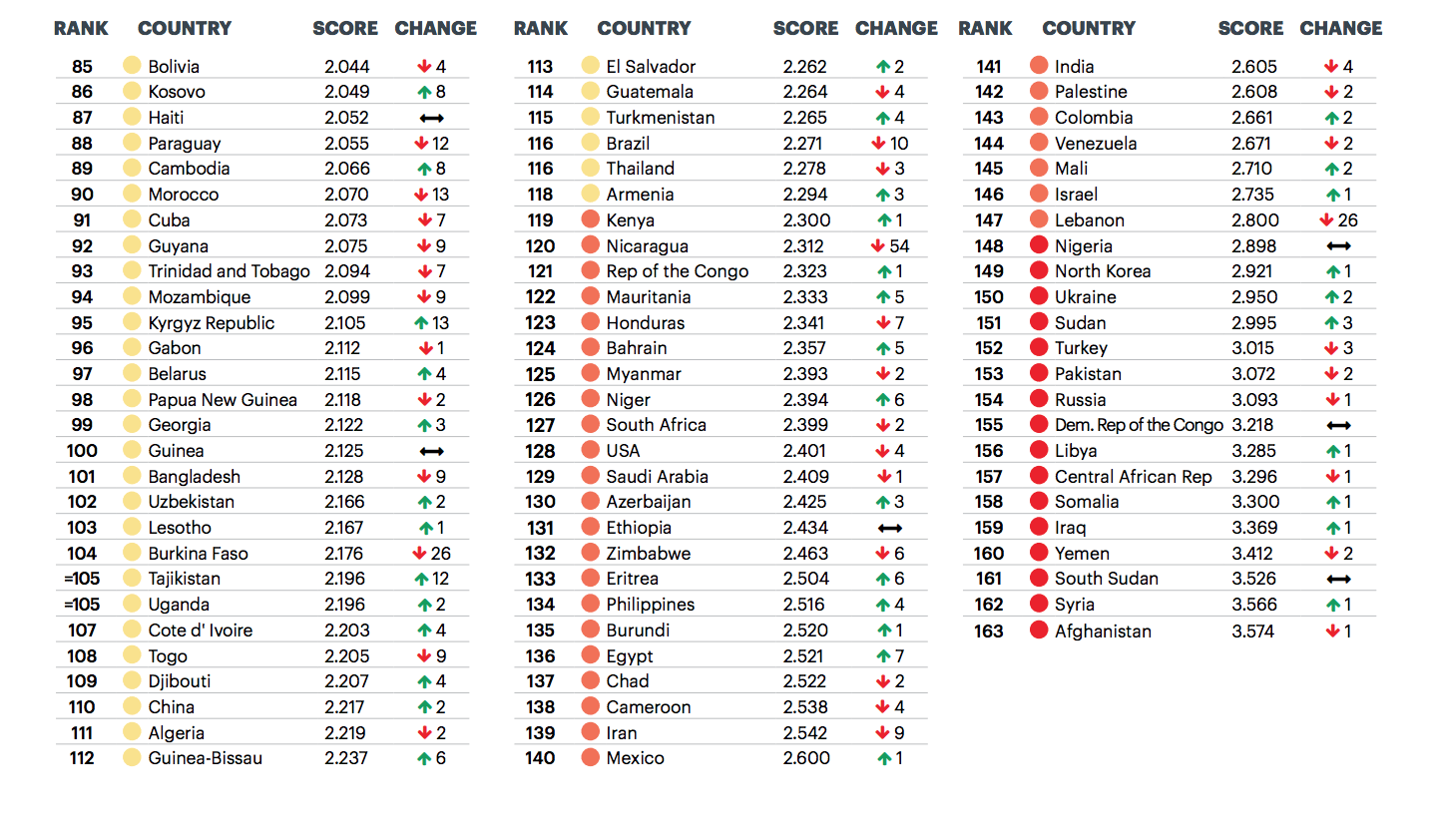Afghanistan is now the least peaceful country in the world, replacing Syria, according to the latest Global Peace Index published Wednesday. Meanwhile, Iceland is retaining its position as the most peaceful country since 2008.
The index from the Institute for Economics & Peace also reveals that for the first time in five years, there is a slight improvement in global peacefulness. On average, country scores improved 0.09 percent, as 86 countries recorded more peacefulness and 76 countries showed deterioration.
However, even as some crises and conflicts of the last decade finally begin to subside, the report found that the world is notably less peaceful than 10 years ago. Compared to 2008, the average level of peacefulness is 3.78 percent lower. Only three times in the last decade has the index recorded any overall improvement.
Specifically, Bhutan has shown the most relative improvement over the last 12 years, jumping 43 places. Georgia also gets the distinction of being the only country to become over 20 percent more peaceful from 2008 to now. But this year, the five countries that improved the most in ranking were Rwanda (which rose 24 places to secure no. 79), North Macedonia (23 places to share no. 65 with Greece), Egypt (seven places to no. 136), Sudan (three places to no. 151) and Ukraine (two places to no. 150).
Sharing the top of the index with Iceland are New Zealand, Portugal, Austria, Denmark and Canada. As a region, Europe remains the most peaceful, while the Middle East and North Africa are still the least peaceful. Somalia, Iraq, Yemen, South Sudan and Syria join Afghanistan at the bottom of the index.




According to the report, this is actually the first time that Yemen has been listed among the five least peaceful countries. This comes as observers concede that the December 13 “Stockholm agreement” signed by the country’s warring parties is all but dead.
Despite the Middle East and North Africa’s poor showing again on this year’s index, the region as a whole has actually become more peaceful in the last year. The only region to improve more was Russia and Eurasia. The report attributes these improvements to a de-escalation of violence in Ukraine and Syria resulting in fewer deaths from conflict. This has also led to fewer deaths from terrorism.
The Asia-Pacific and Europe also became more peaceful over the past year, but all three regions in the Americas have deteriorated. Central America and the Caribbean declined the most, followed by South America, then North America. Here, political instability has been the main opposition to peace, with violent unrest in Nicaragua and Venezuela, for example, and increasing political division in the U.S. and Brazil.
What Makes for a “Peaceful” Country?
To arrive at these findings, the Institute for Economics & Peace ranked 163 countries and territories (representing 99.7 percent of the world population) according to indicators that measure levels of societal safety and security, the extent of ongoing domestic and international conflict and the degree of militarization.
Since 2008, 17 of the 23 indicators have recorded less peacefulness on average, with the “ongoing conflict” category worsening the most – nearly 9 percent – and “safety and security” deteriorating more than 4 percent. This has mostly been the result of internal conflict and 104 countries recording increased terrorist activity. Only 38 countries have improved on this front over the last decade.
However, militarization has improved 2.6 percent in that time as well, with both military expenditure (as a percentage of GDP) and number of personnel (per 100,000 people) dropping in 98 countries and 117 countries respectively.
While the Global Peace Index measures “the absence of violence or fear of violence” (called negative peace), this year’s report also acknowledges that positive peace – “the attitudes, institutions & structures that create and sustain peaceful societies” – is vitally important. Without strong positive peace, countries that currently rank highly on the Global Peace Index may crumble into violence when a shock – such as a political conflict, climate disaster or economic downturn – occurs.
That’s why Sustainable Development Goal 16 isn’t just about reducing conflict. Instead, it aims to “promote peaceful and inclusive societies for sustainable development, provide access to justice for all and build effective, accountable and inclusive institutions at all levels.” Otherwise, the slight improvement the world saw this year will remain just that – a blip of good news on a landscape of bad.
The Institute for Economics & Peace also produces an index on terrorism around the world. Daniel Hyslop, research director at the Institute for Economics and Peace, came on the podcast to discuss what big data can teach us about terrorism around the world.
To access to this podcast episode: subscribe on iTunes, Stitcher, Spotify
